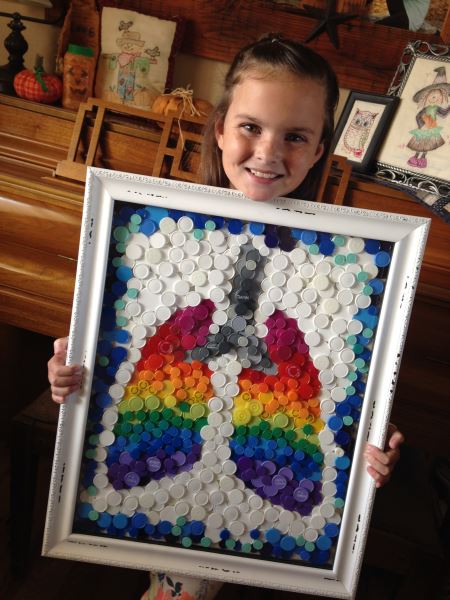
Cystic Fibrosis: A Reason to Run
One brave little girl’s story of living with cystic fibrosis
Blackfoot, Idaho – April 2018 – Emersyn Drollinger is a talented and optimistic nine-year-old little girl with a bright smile, warm, honey-colored eyes, and a heart of gold. She’s a busy third grader who loves riding her bike and reading—especially the Harry Potter and Charlie Bone series! In addition, she’s currently learning to sew and loves to draw, write, and create artwork. Most of all she loves cross-country running.
What many people don’t know, though, is that Emersyn is also a brave little girl who was diagnosed with cystic fibrosis as an infant. According to the Cystic Fibrosis Foundation (CFF), today, approximately 30,000 people in the United States have cystic fibrosis, which is a rare, genetic disease that causes severe damage to the lungs and digestive system.
Her parents are Lisal and Trevor, and she has two older sisters: Paytin, a cross-country and track runner and a freshman at Utah State University, and MaKay, a 16-year-old sophomore at Shelley High School and a runner on their cross-county team. As a family, they support the annual Wolverine Canyon Marathon in Blackfoot because it helps to raise money and awareness for cystic fibrosis.
“When we welcomed Emersyn to our family nine years ago, we never imagined she would be diagnosed with cystic fibrosis,” her mother, Lisal, said. “Initially, we worried about how we were going to care for her, but we have been so blessed—blessed with a very energetic and healthy little girl and the love and support of family, friends, teachers, and members of our local church.”
To help prevent thick, sticky mucus from building up in her lungs, pancreas, and other organs, her parents and a team of caregivers that include pulmonologists, a pediatrician, respiratory therapists, a pharmacist, and a dietitian manage Emersyn’s cystic fibrosis closely. This mucus can trap bacteria, which leads to infections that can cause extensive lung damage and breathing issues.
While she’s like every other third grader, she has a routine that is slightly different. For example, Emersyn has to take daily breathing treatments, which include a shake vest and nebulized medications, starting early every school day at 6 a.m. (A shake vest is a vibrating device that helps to keep her airways clear of any mucus.) She also uses nebulizers frequently after school for about 30 minutes and nebulizers and the vest before bed each night.
Some might think that having to endure this structured schedule would get Emersyn down. “She’s never complained about it,” her mother said. “She has always been very compliant and agreeable. It’s how life has been from the beginning and she doesn’t know any other way. She does say that she breathes easier and feels much better after her treatments.”
Early on, Emersyn’s pulmonologist learned that her parents and her two sisters were runners. Her doctor told her parents that if they could get Emersyn running, that would help save her life because running would minimize mucus build up in her lungs.
Because a family of runners surrounds her, it was only natural for Emersyn to become a passionate runner, too. Her mother is a volunteer for the Shelley High School cross-country team, of which Emersyn is an active member. Her older sister was on the team and her other sister, MaKay, is currently on the team.
“Everyone on the cross-country team has become a special family for Emersyn,” Lisal said. “There are some really great teenagers at Shelley High who’ve created a safe, nonjudgmental, and healthy space for Emersyn for the last several years. During her last hospitalization, she was very motivated to be discharged in time to watch her team run at their district meet. She didn’t want to attend school while she was receiving home IV therapy, but she knew there wasn’t a person on the cross country team that wouldn’t welcome her back no matter what tubes she was attached to.”
With the support of some great coaches and friends, even though Emersyn is only nine-years-old, she is able to participate in some races at the junior high school level! She may be smaller than almost everyone else at the start line, but you can usually find her somewhere in the middle of the pack.
Having cystic fibrosis also affects the pancreas because the buildup of mucus prevents the release of digestive enzymes that allow the body to break down food and absorb vital nutrients. This can result in malnourishment, poor growth, brittle bones, and difficulty gaining weight, despite a healthy appetite. And, in the liver, thick mucus can block the bile duct, causing liver disease. To be proactive, Emersyn takes pancreatic enzymes each time she eats and her meals consist of a high fat, high calorie diet.
“She’s the best nutrition label reader that I know,” Lisal said. “She knows that she has to consume at least 20 grams of fat during breakfast and dinner. In between, she just has to consume as many calories as possible.”
The past nine years have taught the Drollinger family some very valuable lessons, including trying their best to treat everyone they meet with kindness because even though someone may appear “normal” on the outside, you never know what internal struggles they may be dealing with. They have also recognized how important it is to increase awareness and support cystic fibrosis research to give others the chance for a brighter future. The monetary donations to support cystic fibrosis research 20-plus-years ago have paved the way for Emersyn (and so many others!) to have the fulfilling childhood she has today.
Throughout the past ten years, significant progress has been made developing medications that help to prolong the life of someone who has cystic fibrosis. When Emersyn was diagnosed with cystic fibrosis in 2009, the life expectancy was, on average, 35-years-old. Now, because of studies and new medications, the life expectancy for those with cystic fibrosis is in the mid-40s. Ultimately, doctors are working to ensure a child with cystic fibrosis has less lung damage and scarring from mucus build up early on in life so things will be more manageable as an adult.
Emersyn is now taking a new medication called Orkambi, which maintains the balance between salt and water in her body, preventing mucus from clogging the lungs and ducts of organs. “I’m so grateful to be living in a time where there are so many exciting drug developments for those with cystic fibrosis,” Lisal said. “While there still isn’t a cure, there is hope and that’s more than we could all ever ask for.”
As a family, they support the annual Wolverine Canyon Marathon in Blackfoot because it helps to raise money and awareness for cystic fibrosis. “My older daughter, Paytin, and I ran in it last year and she even placed first in the half marathon,” Lisal said. “This year, Emersyn is going to run a 5K. We have to support these kinds of events so that money raised today can help even more people 20 years from now.”
Emersyn is a talented and inspired young artist who has created several works of art out of the medicine vial caps from her treatments that she has donated to medical offices in Eastern Idaho. She also created one set of lungs that hangs in the Cystic Fibrosis Center at Primary Children’s in Salt Lake City, Utah.
As you can see, Emersyn is not allowing anything to hold her back—she’s running her own life’s marathon and doing an amazing job—and we look forward to seeing more of her artistic creations in the future!
Annual Wolverine Canyon Marathon: Join us in the fight against cystic fibrosis!
To help raise awareness about cystic fibrosis, the Bingham Health Care Foundation and Blackfoot Rotary have teamed up to bring you the annual Wolverine Canyon Marathon:
Sat., August 18, 2018 | Blackfoot, Idaho
All of the proceeds from the Wolverine Canyon Marathon will go to charitable foundations. Fifty percent will go to the Blackfoot Rotary Club and the Bingham Health Care Foundation, and 50 percent will go to the Boomer Esiason Foundation for cystic fibrosis.
To learn more about the marathon or register please visit: www.Wolverine.run


